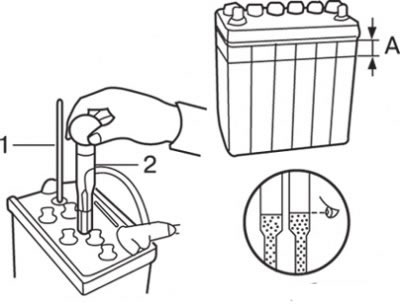1. Using a metal brush, clean the battery terminals and wire terminals. If necessary, rinse the terminals with a solution of baking soda and warm water. Be careful not to let the soda solution get into the battery banks.
2. Lubricate the terminals with acid-free Vaseline and anti-corrosion compound before connecting the battery clamps.
3. Periodically (once a quarter) check the degree of charge of the battery, for which measure the density of the electrolyte in the battery banks.
Checking the level and density of the electrolyte
The electrolyte level must be between the marks «UPPER LEVEL» (top level) And «LOWER LEVEL» (Lower level), marked on the battery case.

Pic. 19.1. Checking the density of the electrolyte in the battery: A is the optimal electrolyte level; 1 - thermometer; 2 - hydrometer
Using a hydrometer and thermometer, measure the density and temperature of the electrolyte (pic. 19.1).
The density of the electrolyte depends on the temperature, so to convert the measured value to the density at 20°C, use the following formula:
D20 = Dt + 0,0007 (t – 20), Where
D20 is the density of the electrolyte, reduced to a temperature of 20°С;
Dt is the result of the actual density measurement;
t is the actual electrolyte temperature.
Charging the battery
When charging the battery installed on the car, first disconnect the negative wire from its terminals, and then the positive one, so that there is no damage to electrical parts.
The charging current is usually 1/10 of the battery capacity.
In the case of fast charging due to lack of time, etc. The charging current must never exceed the battery capacity specified in amps.
The battery is fully charged in the following cases:
- the reduced density of the electrolyte became equal to 1.250–1.290 and remains constant for an hour;
- the voltage of each battery cell is 2.5-2.8 V and remains constant for an hour.
Attention! Be careful and watch the electrolyte level, which may rise during the charging process.
Warning! It is not allowed to charge the battery near sources of fire due to the risk of explosion.
Attention! Do not engage in work that may cause sparks while charging the battery.
Attention! After the battery is charged, replace the lids of the jars, rinse the outside of the battery with clean water to remove acid residue, and wipe dry.
